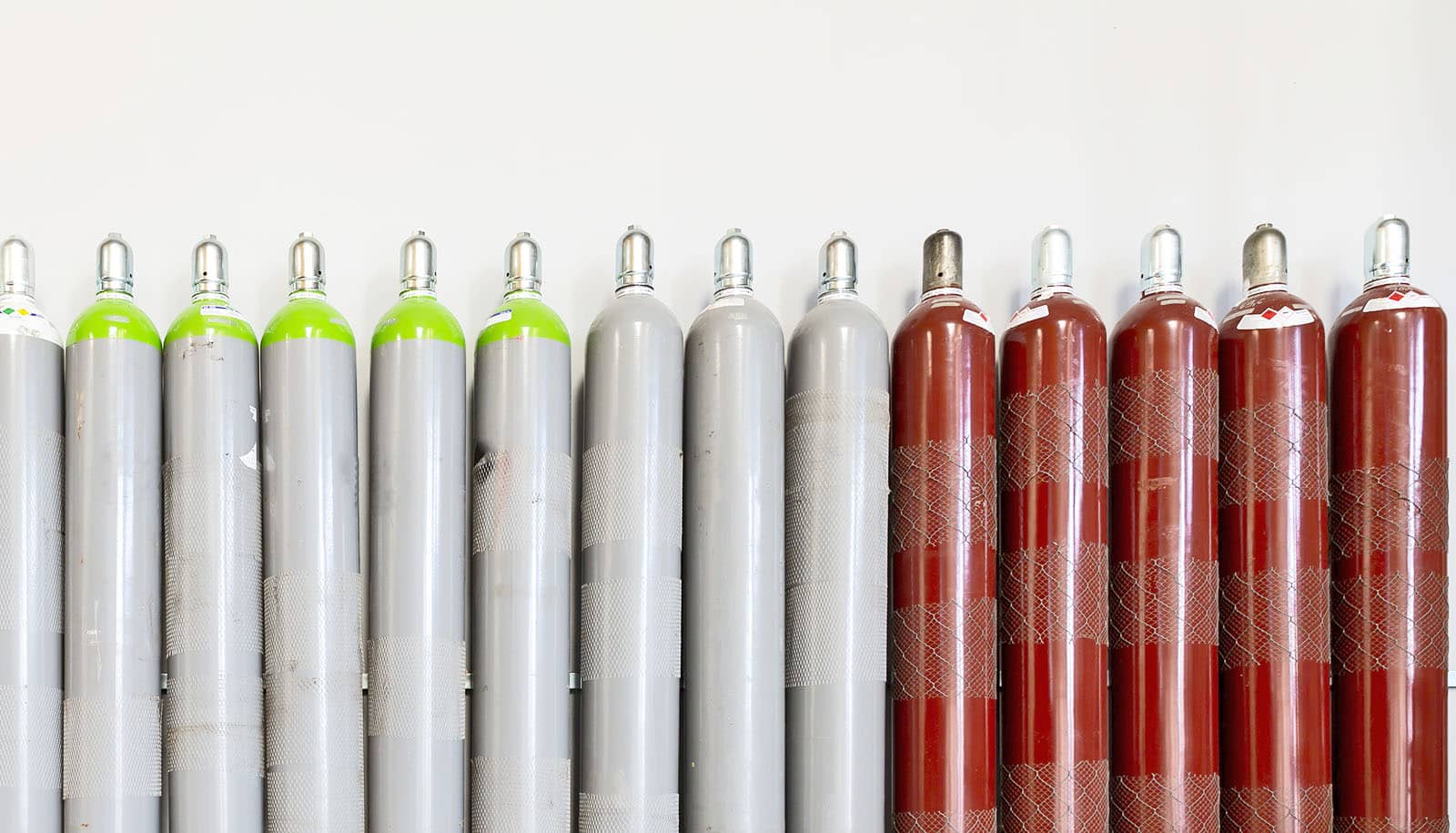
"Particles float around in the atmosphere for at least a week on average," researcher Ryan Sullivan says. "They're so dynamic—their composition and other properties are constantly evolving." (Credit: Dima Pechurin/Unsplash )
‘Tweezers’ show how particles evolve in the atmosphere
"The optical tweezers allow us to ... directly probe the dynamic evolution of all these critical properties of atmospheric particles and how they feedback on each other as each particle continues to evolve."

New research shows how aerosol optical tweezing can allow scientists to scrutinize particles in the atmosphere with new precision.
“What this allows us to do, really for the first time, is directly probe and understand how particles evolve in the atmosphere,” says Ryan Sullivan, associate professor of chemistry and mechanical engineering at Carnegie Mellon University’s Center for Atmospheric Particle Studies.
Optical tweezers take advantage of the small forces exerted by light to trap and gently manipulate small particles or droplets. Arthur Ashkin won the 2018 Nobel Prize in Physics for developing the technique. In aerosol optical tweezing (AOT), individual particles are gently levitated, or “tweezed,” in a laser beam, while a Raman vibrational spectrum of the particle is collected using the same laser light.
“With other techniques, you kind of get a static snapshot of the particle,” Sullivan explains. But with AOT, researchers can watch the same particle for hours as it changes in response to different stimuli, which is a much more realistic way to observe how they might behave in the real atmosphere.
“Particles float around in the atmosphere for at least a week on average,” Sullivan says. “They’re so dynamic—their composition and other properties are constantly evolving.”
That evolution can result not only in the changing of particles emitted into the atmosphere from Earth, but also in entirely new ones that are forming. Secondary organic aerosols (SOAs) are molecules formed directly in the atmosphere from the oxidation of organic molecules, such as those trees, vehicles, and consumer products emit. These particles are an important but highly variable component of the atmosphere and can have effects on pollution, air quality, clouds and climate, and human health.
Secondary organic aerosol
In a 2017 study in the journal Environmental Science & Technology, Sullivan’s lab captured and analyzed secondary organic aerosol for the first time with AOT. He worked with Neil Donahue, a professor of chemistry and chemical engineering, and Kyle Gorkowski, a postdoctoral researcher at McGill University who worked on his PhD with Sullivan and Donahue.
“It’s very complex material,” Sullivan says of working with SOA, which the researchers generated directly in the AOT chamber from ozone reacting with the organic vapor α-pinene, a terpene molecule from trees. “You will get dozens or hundreds of different chemical products as a result—it’s like a runaway chain reaction with all sorts of branching.” This SOA is a major component of atmospheric particulate matter and the AOT approach provides a unique way to directly study its properties and chemistry.
Using their tweezed SOA particles, Sullivan and his collaborators published a study the following year in the journal Environmental Science: Processes & Impacts reporting their new method to analyze the properties and morphology of particles that separate into two separate chemical phases based on the Raman spectra collected from the AOT. In most cases the SOA formed a separate shell phase around another core phase, and their new analysis allowed them to determine the properties of both phases as they change through continued chemical reactions.
The results were the first direct confirmation of what researchers had suspected about SOA droplets —that they would “phase separate” in the atmosphere, forming a core of aqueous or hydrophobic organic material surrounded by a shell of oxidized secondary organic material.
Understanding the exact morphology of SOAs is important, Sullivan notes, because what’s at the surface of a particle can determine how easily it reacts with other gases, water vapor, and light in the atmosphere. For example, many important trace gases in the atmosphere react much more quickly with aqueous phases than with organic material.
“If I’m a molecule that really wants to react with water, and I have to burrow and diffuse through this organic shell, I may not reach the aqueous phase that I want to react with in time,” Sullivan explains. These organic shells can thus shut down important gas-particle reactions.
Particles in the atmosphere and droplet pH
In a new study in the journal Chem, Sullivan, Donahue, and Gorkowski restaged the experiments behind the team’s 2018 work showing phase separation of SOA but under different conditions.
“We wanted to see if the conclusions we had drawn about phase separation and morphology for secondary organic aerosol at higher relative humidity held at lower relative humidity when there is less water vapor around,” Sullivan says. “And they do.”
In addition, the study compiles results and observations from previous research to build a predictive formula for when a phase separation would occur when different organic materials are oxidized under different conditions, and what the morphology of that resulting complex phase-separated particle including SOA would be. Sullivan believes this new insight can be incorporated into current chemical models that predict the behavior and evolution of atmospheric particles over global scales.
In another new study, Sullivan, Gorkowski, and Hallie Boyer, an assistant professor of mechanical engineering at the University of North Dakota and former postdoctoral researcher at Carnegie Mellon, developed a technique to precisely measure the pH of tweezed droplets to determine their acidity. The research appears in the journal Analytical Chemistry.
“The pH of droplets is a huge open question in the atmospheric chemistry of particles because acidity is such a key property for essentially all chemical behavior,” Sullivan says. The property can not only affect how and if reactions occur between different particles, but it can also determine whether a particle ends up becoming phase separated or not.
While determining pH is not a difficult process under normal circumstances, measuring it directly from suspended picoliter aerosol particles has challenged the atmospheric chemistry community for decades, Sullivan notes. In particular, the high concentration of ions in atmospheric particles leads the ions to interact with each other more so than in most substances, producing “nonideal” chemical interactions that can significantly alter the droplet’s acidity.
By combining two different pieces of information uniquely determined from the Raman vibrational spectra of the particles, the team was able to develop a technique to overcome these challenges and measure the pH of each droplet directly with high accuracy. In addition, they were able to track changes in the droplet’s pH. In forthcoming work, they also demonstrate the ability to observe changes in the pH of both the core and shell of phase-separated particles independently over time.
With all of the tools now in place, Sullivan is looking forward to building on all of this aerosol optical tweezing work by using the technique to study a wide variety of particles and chemical interactions in Earth’s atmosphere in a realistic way.
“The optical tweezers allow us to for the first time directly probe the dynamic evolution of all these critical properties of atmospheric particles and how they feedback on each other as each particle continues to evolve,” Sullivan says.
Funding for the Chem and Analytical Chemistry publications came from the National Science Foundation. Hallie Boyer had support from a postdoctoral fellowship from the Dreyfus Foundation.
Source: Ben Panko for Carnegie Mellon University
The post ‘Tweezers’ show how particles evolve in the atmosphere appeared first on Futurity.
Share this article:
This article uses material from the Futurity article, and is licenced under a CC BY-SA 4.0 International License. Images, videos and audio are available under their respective licenses.
Related Articles:
How nature handles all that nitrogen
Sept. 22, 2022 • futurityPlatinum is great at splitting water for a surprise reason
Jan. 2, 2020 • futurityLinks/images:
- https://www.futurity.org/poplar-trees-genetic-modification-greenhouse-gases-2250572/
- https://www.futurity.org/emissions-regulations-air-pollution-2031722-2/
- https://www.futurity.org/3d-printers-particles-air-quality-2178502/
- https://www.futurity.org/air-pollution-mental-health-1594622/
- https://doi.org/10.1021/acs.est.7b03250
- https://doi.org/10.1039/C8EM00166A
- https://doi.org/10.1016/j.chempr.2019.10.018
- https://doi.org/10.1021/acs.analchem.9b04152
- https://www.cmu.edu/news/stories/archives/2020/february/optical-tweezers.html
- https://www.futurity.org/particles-in-the-atmosphere-secondary-organic-aerosols-2291892-2/
- https://www.futurity.org


